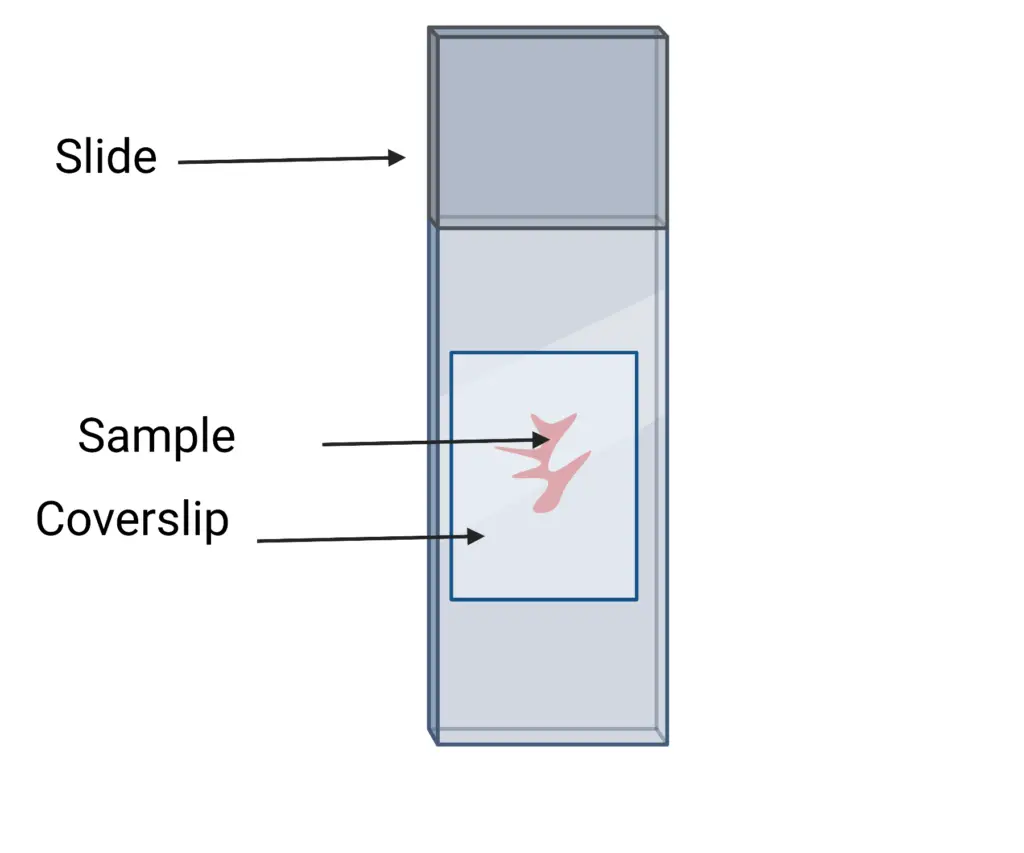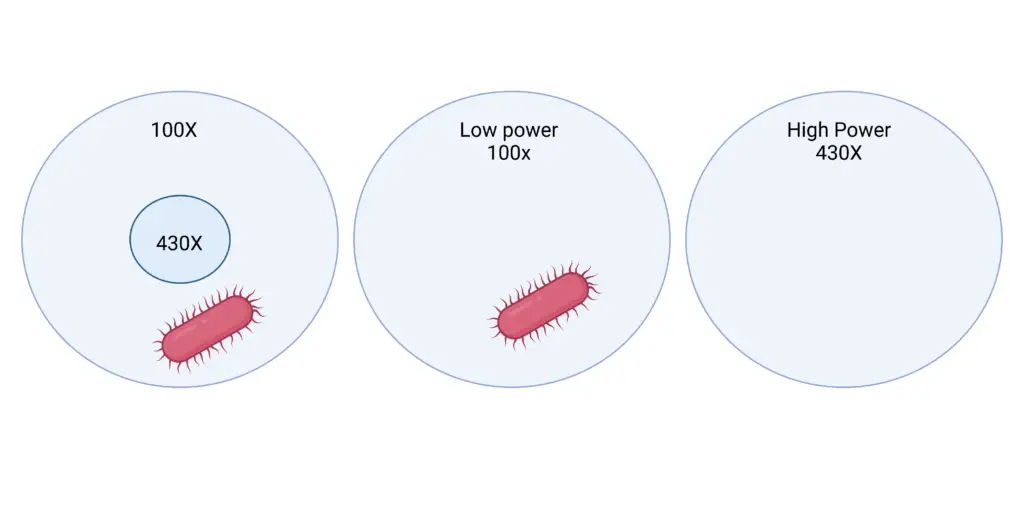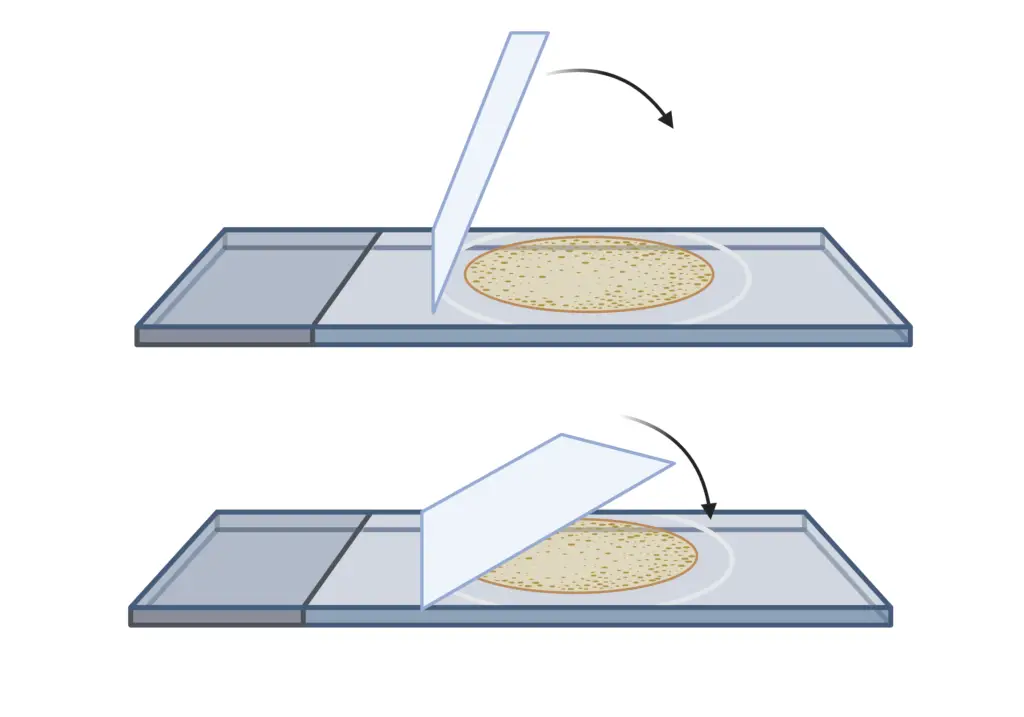Table of Contents
- Carry the microscope close to your body, with one hand on the arm and the other on the base, when moving it. If you are confused of which component of the microscope is which, I suggest starting with this section on Microscope Parts & Functions.
- After removing the dust cover, if applicable, and plugging in the microscope, position the excess cord in a manner that prevents you from tripping over it and knocking the microscope over. Because a microscope is a precision equipment, sharp motions or impacts might set off its delicate components.
- As a general guideline, always begin and conclude with the lowest magnification objective on the microscope (often 4X), as it is easier to focus and centre the sample in the picture at a lower magnification. Also, as it is the objective lens with the smallest focal length, there is the least possibility of scratching the lens when positioning or removing the microscope slide. The image below demonstrates how to properly mount a sample onto a slide.

- Turn on the microscope and position the slide with the specimen directly over the circle of light on the microscope stage. You will then have a 90% chance of locating the specimen upon first looking through the eyepiece. If your microscope has a single eyepiece, you should close or cover your other eye for accurate and comfortable viewing. If your microscope is binocular, adjust the interpupillary distance (the distance between the eyepieces) by sliding or rotating the eyepieces (called adjusting the diopter if the microscope has one) until you can see only one circle of light while both eyes are open.
- NOTE: Remove your glasses; if you can only see your eyelashes, move closer. If your microscope has eyepieces with a high eye point, such as our SM and ZM stereo zoom microscopes, you do not need to remove your glasses.
- If the magnification level is at its smallest, focus the image by first rotating the coarse focus knob. If the object cannot be brought into focus with the coarse focus knob, go to the fine focus knob.
- Adjust the aperture while viewing via the eyepiece. You will begin to observe that greater detail is discernible when less light is allowed in. Overexposure to light tends to cause the specimen to appear washed out.
- Once the specimen has been focused on low power (typically a 4X objective), centre it in the field of view and switch to a higher magnification objective without adjusting the focus knobs (10X objective, then 40X objective). If the specimen is not centred, it will be lost when switching to higher powers.

- Remember to only use the fine focus knob to bring the image into sharp focus once the magnification has been increased. This knob, if present, is often smaller than the coarse focusing knob and moves the stage a considerably shorter distance. Due to the near proximity of the higher magnification objectives to the slide, using the coarse focus knob can damage the lens and shatter the slide.
- Utilize the 100X objective with caution. As it is an oil immersion lens, using it without the oil to lubricate it can result in lens damage and a hazy image of the sample. Place one drop of oil between the cover slip and objective lens of the slide. Slowly apply more oil until it completely covers the space between the objective lens and the slide. The oil will also assist gather sufficient light to look through the lens and minimise image distortion.
Making a Wet Mount
- Collect a small slice of the specimen. If your specimen is too thick, the coverslip will not lie flat and will jiggle on top of it. The image below depicts an erroneous mounting of the cover slip, which makes it difficult to focus on the sample.
- Place ONE drop of water directly on top of the sample. Too much water will cause the coverslip to float on top of the water, which will cause the specimen to float in and out of your range of view.
- Place the coverslip on the slide at a 45-degree angle, with one edge contacting the water drop. Allow the coverslip to fall onto the specimen as you release your grip.

Staining a Slide (After Making a Wet Mount)
- Place one drop of Methylene Blue (or similar stain sold separately by another vendor) on one side of the coverslip and the flat edge of a paper towel on the opposite edge.
- As the paper towel absorbs the water from under the coverslip on one side, the flow of liquid will absorb the stain from the opposite side.
- As soon as the stain has covered the specimen-containing area, you are finished. It is not necessary for the stain to extend under the entire coverslip. If the stain does not cover the desired area, continue the procedure with a new paper towel and additional stain.
- Be sure to remove the excess discoloration with a paper towel so that the objective lenses are not permanently stained.
- You are now prepared to position the slide on the microscope stage. Follow all preceding instructions on how to operate a microscope properly.
- After use, be sure to wash and dry both the slide and the coverslip.
Adjusting Focusing Tension
- Basic (B100, M500 Style) Compound Microscope: Use the instrument included with the majority of microscopes to adjust the focusing tension according to the illustration on the right.
- Stereo Zoom (SM & ZM) Microscopes: In the vast majority of SM and ZM microscopes, the tension system is situated on the focusing rack as opposed to the head. The dual knobs on the focusing rack must be turned in opposite directions to increase or decrease system tension.
- Advanced (600 & 800 Series) Compound Microscopes: On our advanced models, there are two distinct designs. To loosen or tighten the focusing tension on models from the 680 and 800 series, use the wrench provided.

There is a ring on the inside portion of the right-hand focusing knob on all other compound microscope versions (490 and above). This ring can be manually adjusted to increase or decrease tension.

Changing the Eyepiece (M Series Microscope)
A little screw is located on the side of the eye tube. Use a tiny screwdriver (usually a 1mm precision screwdriver) to loosen the screw so you may remove and replace the eyepiece. If you must invert the microscope for any reason, tighten this screw or remove the eyepiece to prevent harm.
Color Filter Installation
If the microscope has a swing-out ring holder, place the colour filter in it. This design is typically found on cameras with an Abbe condenser and an adjustable iris. If the swing holder is facing the body of the microscope, simply twist the condenser assembly until the swing holder is facing forward.
Typically, microscopes with a disc-style iris condenser do not include a filter holder. In this instance, the filter may be simply positioned and centred on the microscope’s base illuminating lens or cover.

